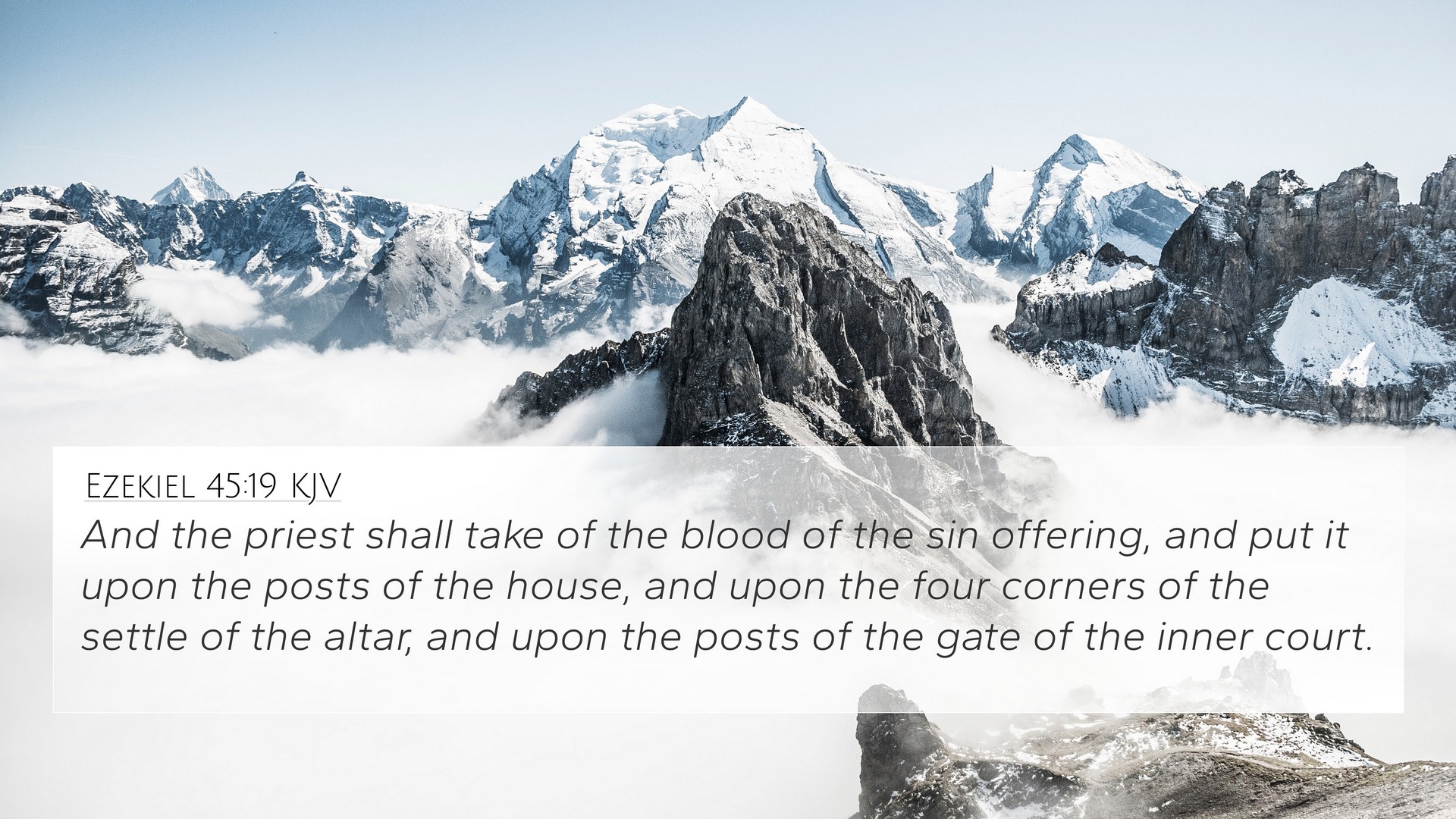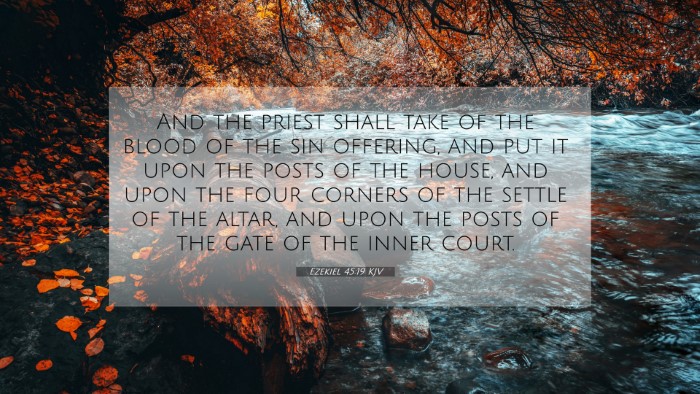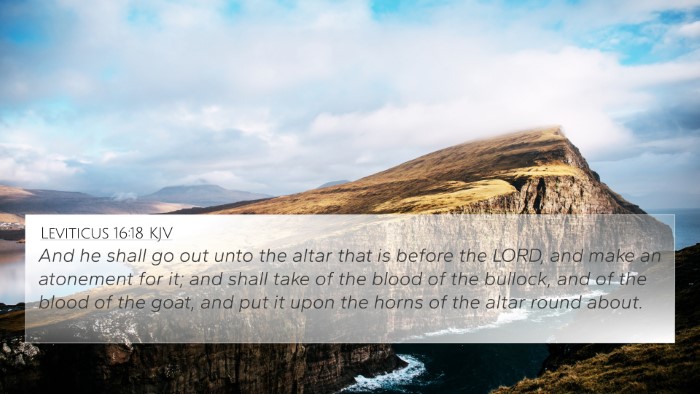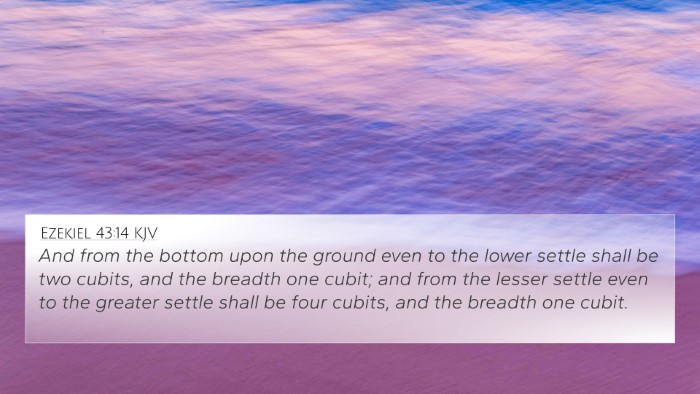Ezekiel 45:19 states: “And the priest shall take of the blood of the sin offering, and put it upon the posts of the house, and upon the four corners of the settle of the altar, and upon the posts of the gate of the inner court.” This verse falls within a detailed description of the offerings and the rituals to be conducted by the priests. Below is a comprehensive summary of the meanings derived from public domain commentaries including those by Matthew Henry, Albert Barnes, and Adam Clarke.
Meaning and Explanation
This verse is significant in understanding the sacrificial system and the role of the priest in ancient Israel. It emphasizes the act of atonement where blood is involved, representing both the seriousness of sin and the means of reconciliation with God.
Historical Context
Ezekiel was a prophet during the Babylonian exile, addressing the Jewish people about their sins and the coming restoration. This chapter discusses the future temple, its offerings, and the restoration of proper worship practices.
Key Insights from Commentaries
- Matthew Henry: Highlights the importance of the blood in the atonement process. He emphasizes that the blood signifies life and redemption, and placing it on the posts symbolizes both protection and dedication to God.
- Albert Barnes: Explains the ritualistic aspects of the verse. He notes that the application of blood signifies the cleansing power of sacrifice, foreshadowing the ultimate sacrifice of Christ. Additionally, Barnes reflects on the importance of maintaining proper worship as commanded by God.
- Adam Clarke: Draws parallels to the Passover and discusses how the sprinkling of blood was essential for both personal and communal atonement. He also emphasizes the need for careful observance of God's commands in worship.
Thematic Connections
This verse showcases several themes central to the biblical narrative:
- Atonement: The shedding of blood is a critical theme throughout the Bible, tying into the concept of atonement for sin, and ultimately leads to the New Testament understanding of Christ’s sacrifice.
- Intercession: The priest's role as an intercessor represents the mediatory function, echoing the priestly role of Christ as the ultimate High Priest.
- God's Holiness: The methods outlined in sacrifices reflect the seriousness of approaching a holy God and the need for purification.
Cross References
When studying Ezekiel 45:19, several other scripture passages can be referenced to expand understanding through inter-Biblical dialogue:
- Exodus 12:22-23: Discusses the blood of the Passover lamb applied to doorposts for protection.
- Leviticus 16:14: Details the ritual of the Day of Atonement where blood is applied in a similar manner for atonement of sins.
- Hebrews 9:22: Affirms that without the shedding of blood, there is no remission of sins, linking Old Testament sacrifices to the New Covenant.
- John 1:29: Refers to Jesus as the Lamb of God who takes away the sins of the world, connecting the sacrificial system to Christ's work.
- 1 Peter 1:18-19: Speaks of Christ's precious blood as the ultimate sacrifice for our redemption.
- Romans 3:25: Discusses Jesus' blood as a propitiation for our sins, indicating the fulfillment of sacrificial laws.
- Isaiah 53:5: Prophecies about the suffering servant who is wounded for our transgressions, tying the Old Testament redemption to the New Testament fulfillment.
Conclusion
The verse Ezekiel 45:19 encapsulates a critical element of the Old Testament sacrificial system, serving as a bridge to understanding the New Testament revelation of atonement through Christ. By examining this verse alongside related scripture, one can appreciate the depth of God’s redemptive plan evident in both Testaments.
Further Study Suggestions
For those interested in a deeper exploration of biblical connections and the themes of sacrifice, consider the following tools and methods:
- Bible Concordance: A systematic tool to find scripture that relates to specific themes or words.
- Bible Cross-reference Guide: A reference guide that helps in locating verses that link together different biblical principles.
- Cross-reference Bible Study: Practice identifying themes and connecting verses through guided studies.
- Identifying Connections: Engaging in comparative studies between Old and New Testament to understand the overarching narrative of redemption.






